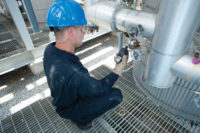Connecting safety managers to advanced benefits from new gas detectors

In hazardous industrial environments today, technological innovations in gas detection that connect workers and remote supervisors with real-time data are revolutionizing the way companies manage safety and productivity out in the field.
Fresh innovations—ranging from Bluetooth-enabled wireless gas monitors, industrial-grade smart phones, longer-lasting batteries and new visualization software—are making life on the job simpler and safer for front-line workers, and providing remote stakeholders with line-of-sight into what’s happening in hazardous areas.
At the heart of the matter is this: companies are adopting connected solutions that provide real-time safety intelligence. The industry is moving away from individual or point solutions, to connected solutions. Critical data—personal and environmental— now can be collected by smart gas monitors, personal protective equipment, biometric monitors and more—and this information can be sent to the cloud and shared across an enterprise with all remote stakeholders using a smart phone, PC or other IoT device. K9 In this way, companies can respond more quickly and decisively to a safety threat, for example, a man down, or a gas leak—or stop the threat before it escalates with catastrophic consequences.
The Bluetooth-enabled gas detector Sensepoint XCL, which will be showcased at Honeywell’s live launch event, is one example. Sensepoint XCL is a wall-mounted device that monitors for hazardous levels of gases such as carbon monoxide or methane in commercial buildings. It can be paired with a smart phone and a free, downloadable app from Honeywell for commissioning and managing the detector, and to generate valuable system reports needed for regulatory compliance.
Controlling the detector from a mobile device in this way not only makes the gas monitors easier to install, maintain and manage, but it allows operators to quickly and easily produce reports needed to meet safety and environmental regulations. What’s more, maintenance personnel don’t have to waste time and effort climbing ladders or crawling into ductwork to maintain gas monitors.
But the possibilities don’t end there. Innovations in software design enable safety managers to derive more value from their safety equipment. Honeywell Sotera Express TM , a new windows based software, provides a common interface and device management solution for BW Technologies and RAE branded portable gas detectors and docking stations, so customers can now benefit from a single Honeywell brand experience to manage their fleet of portable gas detectors. Honeywell docking stations provide additional value to help safety managers save time and expenses on calibration, battery charging, records-keeping and other tasks.
But the possibilities don’t end there. It is possible now to convey information from the front-line worker back to a remote host controller using more pathways than ever before—and more cost effectively. Where companies do not use wireless gas detectors and/or they don’t have Wi-Fi installed, it now means that the end user can achieve wireless connectivity without the expense of a private network. Alternatively, if a worker is using Wi-Fi to communicate back to the office and they step into a blackspot on the site or there are holes in the Mesh radio coverage, they can use an industrial-grade smartphone and app to provide safety managers located off site with constant visibility of their movements.
Companies that deploy wireless monitoring technologies in remote areas typical of the oil and gas industry have begun to combine portable gas detectors with location tracking and software, which can then be used to inform safety managers of the real-time gas status throughout a facility or at a specific location. With this information, managers or stakeholders enterprise-wide, regardless of location, can immediately determine the location and the severity of a gas alarm. They can also draw on instant readings of an individual’s situation, which can then be used to better inform how best to rescue the worker during a man down scenario and potentially evacuate others that might be at risk. Finally, managers can proactively monitor the readings of any gas detector remotely in real-time.
This is vital when it comes to enhancing worker protection. Advances in gas detection systems mean that companies can now automate their reporting and use this data to ensure compliance. Safety managers can scroll through the records of a worker’s gas detectors and uncover the gas readings that they had been exposed to over the previous weeks. This information can then inform how safety is managed going forward. The automated system also frees the supervisor up from having to compile time-consuming reports.
The latest gas detection technology can also help businesses improve productivity in a number of ways. For instance, it allows workers to concentrate on the job at hand instead of worrying about whether their gas detector is working properly. It also identifies trace gas leaks from process equipment, which reduces costly downtime. What’s more, it simplifies the safety audit process so that workers don’t have to be pulled from the field because of non-compliance. Finally, in some confined space scenarios, workers can use wireless technology to report gas detector readings back to their supervisor, thereby removing the need to stop work every few minutes to send this information back manually.
Developments in gas detection technology are moving at a breakneck speed and the possibilities are fascinating to pore over. In the past year, for instance, we have seen the industry’s first wireless four-gas monitor to operate with all of the most essential wireless communication protocols – Bluetooth, Mesh, GPS and Wi-Fi. This means that companies can now use a single device with wireless and non-wireless capabilities to monitor gas hazards in real-time at remote locations. Not only does this enable managers to access critically important information instantaneously from any location but it also provides them with an accurate picture of developments on the ground. Armed with this vital information, they can then respond effectively to events, mitigating or preventing safety incidents.
This is just a snapshot of the cutting edge technology that is transforming gas detection and enhancing worker safety in the process. Clearly, connected solutions that deliver real-time intelligence is where gas detection technologies are advancing. By enabling businesses to integrate data to provide real-time visibility of operations as they unfold, end-users are better placed to make informed decisions. At a macro level, that can mean executing the right emergency response, resolving a small issue before it blows up to become a costly and damaging crisis and, arguably most importantly, making sure that safety is never compromised.
For more information about gas monitoring solutions from Honeywell Industrial Safety, its products and services, visit the website at http://www.honeywellanalytics.com.
Click here to watch the live event on May 18
Looking for a reprint of this article?
From high-res PDFs to custom plaques, order your copy today!








